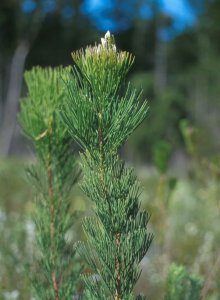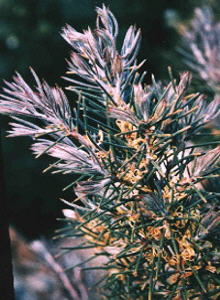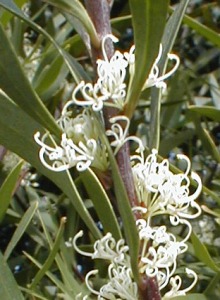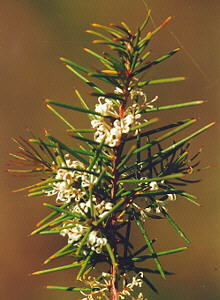
Home
Mission
Overview of Project
Project Staff
Sponsors
Achievements
Checking, Illustrations
Upcoming Activities
Id and Species Lists
Protea Information
Protea Gallery
Growing Proteas
Interim Dist. Maps
Publications
Afrikaanse Inligting
![]()
Needlebushes - Hakea
Rock Needlebush - Hakea drupacea
 |
Habit: An erect shrub or
tree Fire survival: Killed, only seeds survive Sexual system: Both sexes in each flower Flowers: May - June Pollinator: Insects Fruit: Stored on plant Seed dispersal: Wind Seed storage: In follicles on plant Rarity status: An alien invader requiring mechanical removal Habitat: Sandstone and grannite soils, 0-1000m Distribution: Cape Peninsula to Port Elizabeth, Western Australia Note: An alien that resembles a Stone Pine. No biocontrol agents have yet been released to control this invader |
Rock Needlebush - Hakea gibbosa
 |
Habit: A bushy shrub or
tree up to 4m tall Fire survival: Killed, only seeds survive Sexual system: Both sexes in each flower Flowers: June to September Pollinator: Insects Fruit: Stored on plant Seed dispersal: Wind Seed storage: In follicles on plant Rarity status: An alien invader requiring mechanical removal Habitat: Sandstone soils, 0-1000m Distribution: Cape Peninsula to Caledon, New South Wales near to Sydney, Australia Note: A highly invasive alien that poses an enormous threat to fynbos vegetation in the Hermanus area |
 |
Habit: A bushy shrub or
tree up to 4m tall Fire survival: Killed, only seeds survive Sexual system: Both sexes in each flower Flowers: September - October Pollinator: Insects Fruit: Stored on plant Seed dispersal: Wind Seed storage: In follicles on plant Rarity status: An alien invader Habitat: Hedges and windbreaks, is invading pine plantations at Grabouw, Fynbos near Natures Valley and grassland in Swaziland Distribution: Planted throughout southern Africa Note: An up until now non invasive alien that is perhaps starting to spread. However, it is only weakly serotinous and late maturing so few seeds survive fires |
Silky Needlebush - Hakea sericia
 |
Habit: Shrub reaching up
to 5m in dense stands Fire survival: Killed, only seeds survive Sexual system: Both sexes in each flower Flowers: June - September Pollinator: Insects Fruit: Stored on plant Seed dispersal: Wind Seed storage: In follicles on plant Rarity status: An alien invader requiring mechanical removal Habitat: Sandstone and shale soils, 0-1400m Distribution: Cederberg to KwaZulu-Natal and south eastern Australia Note: A highly invasive alien that poses an enormous threat to fynbos vegetation |
Back Needlebushes Gallery